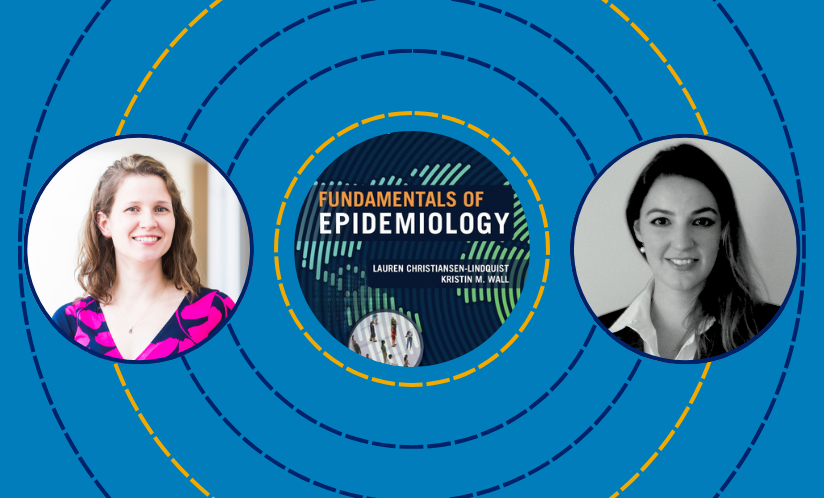
After years of teaching introductory epidemiology to undergraduate students, Lauren Christiansen-Lindquist, PhD, and Kristin M. Wall, PhD, had bonded in their shared frustrations over how textbooks presented the complex field to their students.
“While there are a lot of introductory epidemiology textbooks that have great things about them, none really fit the needs I had as an instructor,” says Christiansen-Lindquist. “One of the challenges we have in epidemiology is it gets so complicated that sometimes you oversimplify early on, which leads to having to unlearn things later. And that's frustrating—both for students and their instructors.”
So, when Tim Lash, DSc, chair of the Department of Epidemiology, was contacted by Springer Publishing Company about their interest in adding an intro to epidemiology textbook to their health sciences series, Christiansen-Lindquist was top of mind. Knowing she couldn’t do it all on her own, she quickly enlisted Wall’s help and, with the book contract signed in October 2020, the two got to work.
The fruition of their hard work has resulted in the recent release of Fundamentals of Epidemiology, a true introductory book to the field of epidemiology. Drawing from their own lectures and knowledge in teaching introductory epidemiology to students over the years, the authors note that the book is conversational in tone and was designed with diverse learners in mind—visual elements, created by Christiansen-Lindquist, are abundant throughout.
A thoughtful design for a complicated subject
Wall also notes that they have added “kindnesses” in the book for students. “Because we’ve taught this subject for so long, we know what the common mistakes are, and we understand why those mistakes happen.”
To help educate and empower their learners, the authors have developed call-out sections throughout the book explaining why common mistakes are made, why they are incorrect, and how to think about them differently. They have also intentionally designed review questions to appear within sections versus at the very end of chapters so readers can more easily recall and practice the information they have just learned. The middle matter of the book is essentially a “cheat sheet” for students that compiles summary sheets and key tables for easy reference, so the book can serve as a practical reference.
“The book is certainly geared toward launching someone into a public health career,” says Wall. “We are hopeful we can help people become better public health practitioners, better epidemiologists.” While tailored toward college students, the authors also note it’s meant to be understood by anyone hoping to gain a foundation in public health—including members of the public.
“Epidemiology is really a framework for critical thinking that is essential to be an informed member of society,” says Christiansen-Lindquist. “This book is not just for epidemiologists or public health professionals, it really can be useful for anyone to help prepare them to make more informed decisions about their health.”
Content for learners and their instructors
As professors themselves, the authors were determined to create the type of book they wanted. So, in addition to the conversational tone of the text and thoughtful arrangement of materials, the authors created a large database of supplementary online content (developed with the help of doctoral students) for teachers that includes:
- A bank of test questions for each chapter
- PowerPoint decks that go along with each chapter
- An instructor guide
The authors also impart their philosophy on teaching intro to epidemiology with instructors who will use the book and explain their approach to the content, as well as provide a head’s up when the content of a chapter may be triggering to some students.
“Fundamentals of Epidemiology is a valuable new introductory text, ideally suited to undergraduate and graduate instruction in epidemiology, and optimized for modern teaching approaches that engage students with active learning and that seek to convey complex epidemiologic and biostatistical concepts clearly and without simplifications that will later need to be unlearned,” Lash writes in the book’s foreword. “The field has needed such a text for as long as I can remember; it is exciting to finally see just such a text become available.”
Writing a book while weathering a pandemic and parenting
Writing a book is a tremendous undertaking in normal times. When placed in the context of a global pandemic, it takes on new challenges that can feel impossible. Throughout the development of the book, the authors were still teaching, conducting research, and juggling the pandemic-specific demands of motherhood—Wall gave birth during the pandemic; Christiansen-Lindquist’s three children were home for an entire academic year.
Despite the workload, the two wrote and published a book that the academic community has been hungry for. They also found a deeper appreciation for each other in the process.
“I think we drew off of each other's strengths,” says Christiansen-Lindquist. “I don't think either of us could have done it alone. Kristin is so thoughtful about the science and the structure and keeping the flow of the writing going. I brought in the visual elements and was able to adjust some of the scientific writing, so it was more approachable for earlier learners... It was fun to work together on it even though it took much longer than we had anticipated. I’m glad we’re still friends!”
Fundamentals of Epidemiology is available everywhere books are sold including IndieBound, Amazon, Target, and Barnes & Noble